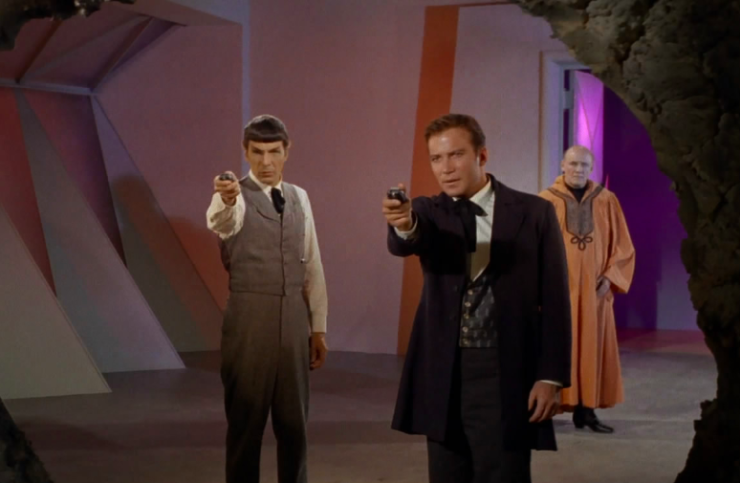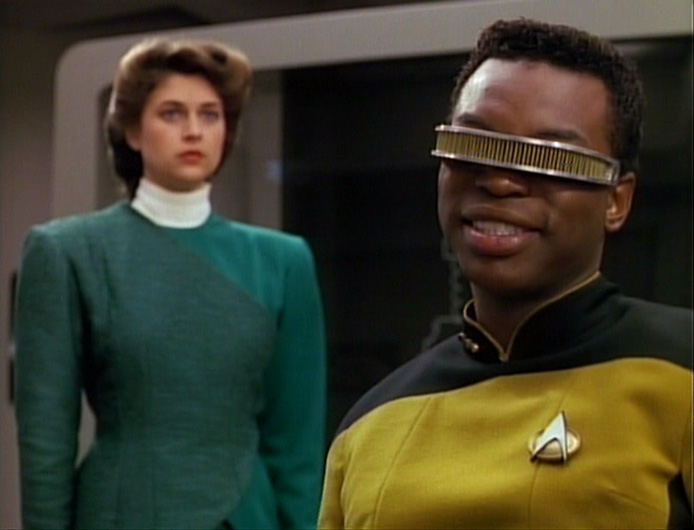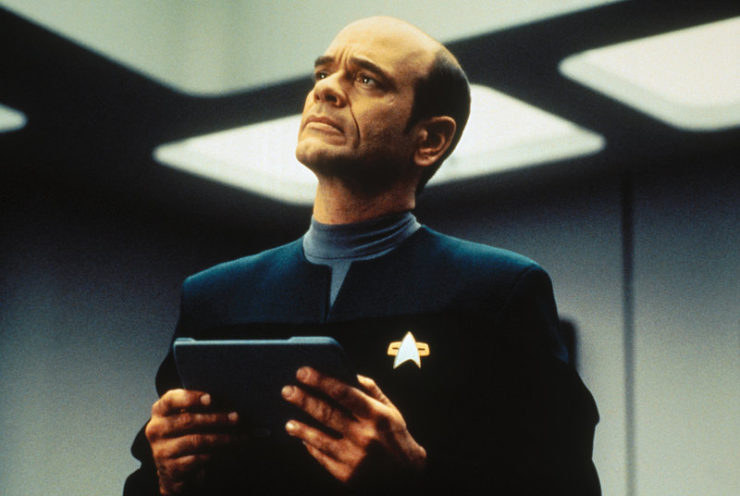Renegade cyborgs and a scheming A.I. became the latest enemies of Starfleet in the latest episode of Star Trek: Discovery, “Project Daedalus.” But beyond the obvious fact that Trek canon has dabbled in evil supercomputer stories many times before, the second season of Discovery has been slowly explaining a more subtle techno-paranoia present across several eras of Star Trek. In “Project Daedalus,” we essentially see why (almost) all other incarnations of Star Trek hate holograms. And not only does this anti-hologram retcon make perfect sense within Trek canon, but it’s also illustrative of real-life fears, too.
Spoilers ahead for Star Trek: Discovery, season 2, episode 9, “Project Daedalus.”
Back in episode 4 of this season of Discovery, “An Obol For Charon,” Pike casually mentions to Number One that he wants all the holographic emitters on the USS Enterprise “ripped-out,” telling his executive officer that holograms are creepy AF and that they look like “ghosts.” But in episode 9, the joke scans as foreshadowing: the out-of-control A.I. called “Control” actually does use a hologram to create a ghost, i.e. the illusion that a dead person—the Vulcan Admiral Patar—is still alive. We also learn that holograms were used to fake evidence that Spock murdered three people in cold (green) blood. Admiral Cornwell was fooled by holograms, Pike was fooled by holograms, and by the end of this season of Discovery, it seems possible that several other interactions might have been engineered via holographic bait-and-switch.
This isn’t just far-future tech. Last year, Jordan Peele created a stir when he proved how easy it was to fake a YouTube video of Barack Obama saying things the former president never said in real life. This wasn’t exactly like the 23rd-century holograms on Star Trek: Discovery, but there’s a clear parallel. As The Verge reported in 2018:
“Yes, we’ve had software to create fakes for a while, but AI makes the whole process easier…Scientists are currently creating tools that can spot AI fakes, but at the moment, the best shield against this sort of misinformation is instilling everyone with a little more media savvy.”
In the original Star Trek series, Captain Kirk practically makes sport of being savvy and unmasking problematic artificial intelligence gone wild. The idea that a relentlessly logical supercomputer will deliberately screw everyone over with misinformation is the central plot of the following ten TOS episodes:
“The Apple”
“I, Mudd”
“The Ultimate Computer”
“Return of the Archons”
“For the World Is Hollow and I Have Touched the Sky”
“The Changeling”
“A Taste of Armageddon”
“What Are Little Girls Made Of?”
And, arguably, “Shore Leave” and “Spock’s Brain”
The plot of “Return of the Archons,” is very similar to “Project Daedalus,” insofar as a huge computer-brain uses a “projection” of a faux person named “Landru” to control an entire planet’s population. In William Gibson’s popular “Sprawl” novels (Neuromancer, Count Zero, Mona Lisa Overdrive) there’s a whole occupation called “Turings,” who are essentially cops whose job it is to make sure artificial intelligence doesn’t get too intelligent. If you watch the original Star Trek through this lens, it almost seems like this was kind of Kirk’s part-time job, too.

The point is, Kirk’s adventures in taking down crazy A.I. supercomputers happen a decade after the events of Discovery. And right now, Discovery is demonstrating how prejudices against both A.I. and holograms are ingrained–or at least becoming ingrained–among members of Starfleet.
In the Star Trek timeline, self-aware A.I. with holographic capabilities are commonplace in the mid-23rd century (Discovery’s era)—seemingly a feasible outgrowth of technology we’re aware of today. But fast-forward to the 24th century (The Next Generation, Deep Space Nine, and Voyager), and A.I. and cybernetic augmentation are treated with extreme prejudice (fascination with Data; fear of the Borg) and holograms are almost exclusively limited to entertainment, training simulation, and other environments in which the participants are aware everything is fake.

In other words, the reason why holograms and their programs stay contained in the holodeck of Picard’s Enterprise in the 2360s is that Starfleet was nearly toppled by A.I.-powered holograms in the 2250s, as chronicled in the events unfolding on Discovery right now. Still, nearly half of the holodeck stories in The Next Generation also deal with the holograms either malfunctioning in dangerous ways (“A Fistful of Datas”) or trying to take over the ship (“Elementary, My Dear Data,” and, famously, “11001001.”) In fact, in “11001001,” you’ve got nearly an identical set-up as in Discovery’s “Project Daedalus.” In that story, cybernetically augmented humanoids—the Bynars—conspire with a sentient hologram—Minuet—to try and take over the ship. Both Picard and Riker are so bamboozled by Minuet, that this scheme nearly succeeds. Nearly 100 years after Discovery, both Picard and Riker are impressed with the realism of a hologram like Minuet; a hologram whose programming effortlessly interacts with the Enterprise-D crew.
Starship computers spontaneously producing artificial intelligence becomes more and more of an issue as the adventures of the Enterprise-D continue onwards. Moriarty’s character programming in the holodeck becomes complex enough to coalesce into self-awareness(“Ship in a Bottle”) and the ship’s own computer eventually becomes aware enough to desire reproduction (“Emergence“). Although Starfleet has spent centuries avoiding the problem of how to recognize and trust A.I.s (and their holographic projections), by the late 24th century it seems that Starfleet programming technology has become too complex and too commonplace to avoid the situation for much longer.
Hence, by the 2370s, Starfleet is very cautiously letting holographic A.I. intelligences serve in Starfleet, culminating with the Emergency Medical Hologram introduced in Star Trek: Voyager. Still, the prejudice against holograms is seriously ingrained at this point. In Star Trek: First Contact, Dr. Crusher clearly hates the idea of the EMH saying “I swore I’d never use one of these things!” before activating the program. Ironically, Crusher uses this hologram to slow down the Borg, thus representing two of Starfleet’s greatest fears—smart holograms and cybernetic augmentation—duking it out.

All of this sets-up the extreme prejudices faced by the Holographic Doctor in Voyager. At some point, because Starfleet is so afraid of A.I.-powered holograms, it essentially creates a race of sentient slaves. In the Voyager episode “Author, Author,” the Doctor writes a holographic memoir called Photons Be Free which results in a philosophical shitstorm that forces the Federation to face a century of deeply ingrained fear and paranoia about holograms. In Voyager, this prejudice felt absurd, because the Doctor was such a beloved character. But Control’s holograms on Discovery are less likable, meaning Star Trek is, in a roundabout way, finally exploring the history of one of the franchise’s longest-running technological phobias.
Certain casting rumors for the new Picard series suggest that a new version of the EMH will appear as part of Jean-Luc’s crew. If so, will Star Trek bring all this hologram/A.I. controversy full circle? And, more interestingly, if a holographic A.I. is central to the new Picard series, will it be aware of the events on Discovery?
Ryan Britt is the author of Luke Skywalker Can’t Read and an editor at Fatherly. He is a longtime contributor to Tor.com.










